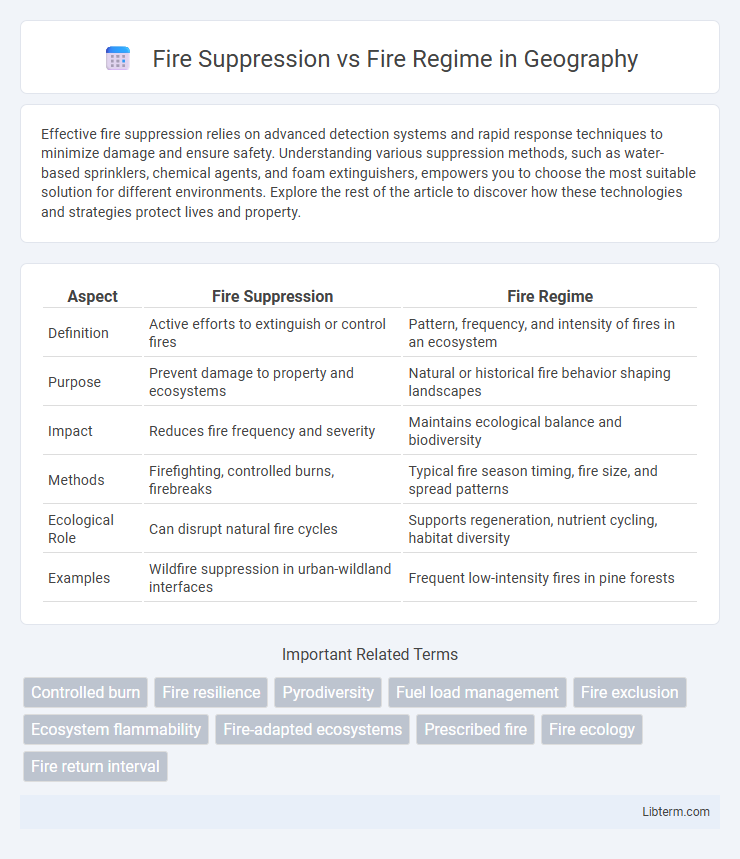Effective fire suppression relies on advanced detection systems and rapid response techniques to minimize damage and ensure safety. Understanding various suppression methods, such as water-based sprinklers, chemical agents, and foam extinguishers, empowers you to choose the most suitable solution for different environments. Explore the rest of the article to discover how these technologies and strategies protect lives and property.
Table of Comparison
| Aspect | Fire Suppression | Fire Regime |
|---|---|---|
| Definition | Active efforts to extinguish or control fires | Pattern, frequency, and intensity of fires in an ecosystem |
| Purpose | Prevent damage to property and ecosystems | Natural or historical fire behavior shaping landscapes |
| Impact | Reduces fire frequency and severity | Maintains ecological balance and biodiversity |
| Methods | Firefighting, controlled burns, firebreaks | Typical fire season timing, fire size, and spread patterns |
| Ecological Role | Can disrupt natural fire cycles | Supports regeneration, nutrient cycling, habitat diversity |
| Examples | Wildfire suppression in urban-wildland interfaces | Frequent low-intensity fires in pine forests |
Understanding Fire Suppression
Fire suppression involves active measures to extinguish or control wildfires rapidly to protect human life, property, and natural resources, often using firefighting techniques such as water drops, fire retardants, and controlled burns. Understanding fire suppression requires recognizing its impact on altering natural fire regimes, which are the patterns, frequencies, and intensities of fires occurring in an ecosystem over time. Effective fire suppression strategies must balance immediate fire control with long-term ecological health to prevent fuel buildup and catastrophic fires.
Defining Fire Regime
Fire regime refers to the long-term patterns and characteristics of fire occurrence, including frequency, intensity, size, and seasonality, shaping ecosystem structure and function. It defines how natural and anthropogenic fires influence vegetation dynamics, soil properties, and wildlife habitats over time. Understanding fire regime is essential for effective fire management, contrasting with fire suppression tactics aimed at immediate fire control rather than ecological balance.
Historical Context of Fire Management
Fire suppression policies emerged prominently in the early 20th century, emphasizing the rapid extinguishment of all wildfires to protect timber resources and human settlements. However, this approach disrupted natural fire regimes--patterns of fire frequency, intensity, and seasonality--which historically played a critical ecological role in maintaining healthy forest ecosystems. Understanding the historical context highlights that fire regimes shaped landscape dynamics long before modern suppression tactics, leading to contemporary shifts toward integrating controlled burns and ecosystem-based fire management.
Ecological Impacts of Fire Suppression
Fire suppression disrupts natural fire regimes by reducing the frequency and intensity of wildfires, leading to increased fuel accumulation and altered plant community structures. This shift can result in decreased biodiversity, changes in habitat availability, and heightened vulnerability to catastrophic fires. Ecological impacts include suppressed regeneration of fire-adapted species and altered nutrient cycling within affected ecosystems.
Role of Fire in Ecosystem Balance
Fire suppression disrupts natural fire regimes, which are critical for maintaining ecosystem balance by controlling invasive species and promoting biodiversity. Regular, low-intensity fires facilitate nutrient cycling, habitat heterogeneity, and regeneration of fire-adapted plants. Altering these fire regimes through suppression can lead to fuel accumulation, increased risk of severe wildfires, and long-term ecological imbalance.
Consequences of Altered Fire Regimes
Altered fire regimes caused by prolonged fire suppression lead to increased fuel accumulation, which escalates the intensity and spread of wildfires. This shift disrupts native ecosystems by reducing biodiversity and altering species composition, often favoring invasive species. Long-term consequences include weakened forest resilience, impaired habitat quality, and greater challenges in fire management efforts.
Comparing Natural vs Human-Influenced Fires
Fire suppression efforts alter natural fire regimes by reducing the frequency and intensity of wildfires, leading to fuel accumulation and potentially more severe future fires. Natural fire regimes are characterized by periodic, low-intensity fires that maintain ecosystem balance and biodiversity, while human-influenced fires often result from land use changes, ignition sources, and fire control policies. The comparison highlights the ecological importance of natural fire cycles and the unintended consequences of aggressive fire suppression on forest resilience and wildlife habitats.
Fire Suppression Policies and Strategies
Fire suppression policies aim to rapidly extinguish wildfires to protect human lives and property, often relying on aggressive tactics like aerial water drops and firebreak construction. In contrast, fire regime strategies focus on maintaining ecological balance by allowing certain fire frequencies and intensities to naturally occur, promoting biodiversity and reducing fuel loads. Effective fire management integrates suppression efforts with regime principles, using controlled burns and monitoring fire behavior to minimize catastrophic wildfire risks while supporting ecosystem health.
Restoring Natural Fire Regimes
Restoring natural fire regimes involves reintroducing controlled burns that mimic historical fire patterns to maintain ecosystem health and biodiversity. Fire suppression disrupts these regimes, leading to fuel accumulation and increased risk of severe wildfires. Effective restoration balances fire suppression with prescribed fires to promote resilience and natural ecological processes.
Future Directions in Fire Management
Future directions in fire management emphasize integrating fire suppression strategies with adaptive fire regimes to balance ecosystem health and wildfire risks. Research focuses on employing predictive modeling and remote sensing technologies to enhance early detection and targeted suppression efforts while maintaining the ecological benefits of controlled burns. Advanced fire management plans prioritize resilience by incorporating climate change projections and promoting collaborative approaches among federal agencies, local communities, and indigenous knowledge systems.
Fire Suppression Infographic

 libterm.com
libterm.com